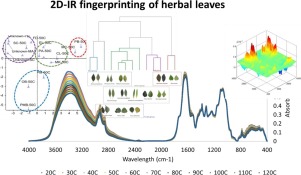当前位置:
X-MOL 学术
›
Vib. Spectrosc.
›
论文详情
Our official English website, www.x-mol.net, welcomes your
feedback! (Note: you will need to create a separate account there.)
A fast and reliable 2D-IR spectroscopic technique for herbal leaves classification
Vibrational Spectroscopy ( IF 2.7 ) Pub Date : 2020-01-01 , DOI: 10.1016/j.vibspec.2019.103014 Muhammad Azfar Firdaus Azlah , Lee Suan Chua , Farah Izana Abdullah , Mun Fei Yam
Vibrational Spectroscopy ( IF 2.7 ) Pub Date : 2020-01-01 , DOI: 10.1016/j.vibspec.2019.103014 Muhammad Azfar Firdaus Azlah , Lee Suan Chua , Farah Izana Abdullah , Mun Fei Yam

|
Abstract The safety and quality of herbal products are of great importance. People take herbal products with the intention for health improvement and overall well-being. Both chromatographic and spectroscopic techniques have been proven for their effectiveness in phytochemical fingerprinting and profiling. The present study describes the application of advanced two dimensional correlation infrared spectroscopy (2D-IR), and followed by chemometrics for herbal leaves classification. The 2D-IR could ascertain small difference and reveal for any overlapping peaks compared to conventional FTIR technique. There were 13 herbs selected and their dried leaves in fine powder form were used for spectral scanning from 400 to 4000 cm−1. The absorption signals were analysed by principal component analysis (PCA) and hierarchical clustering analysis (HCA). It was found that the wavenumber of 1800–900 cm−1 was the dominant region of identification and discrimination. The region was found to have signals attributed to the functional groups of C O, C O and C C stretching, and C H and O H bending. Both PCA and HCA could cluster the IR spectral data of the herbs into 4 distinct groups. There was no significant relationship of leaf morphology and phytoconstituents similarity. Somehow, hairy (Strobilanthes crispa and Morus alba) and waxy (Eurycoma longifolia and Citrus hystrix) leaf surfaces of the herbs are still grouped together after data extraction and reduction using the pattern recognition tools. The classification was also verified by introducing another 3 new spectral data (S. crispa, M. alba and Ficus deltoidea) into the statistical analysis. The new dataset was found to be located at the position near to their individual plant species in both score plot and dendrogram. Although the absorption signals of the new dataset were obtained from their aqueous crude extract, 2D-IR spectroscopic analysis was still capable to capture the key features of discrimination for classification in a precise and rapid manner.
中文翻译:

一种用于草药叶子分类的快速可靠的 2D-IR 光谱技术
摘要 草药产品的安全和质量至关重要。人们服用草药产品是为了改善健康和整体福祉。色谱和光谱技术都已被证明在植物化学指纹图谱和分析中的有效性。本研究描述了先进的二维相关红外光谱 (2D-IR) 的应用,以及用于草药叶子分类的化学计量学。与传统 FTIR 技术相比,2D-IR 可以确定微小差异并揭示任何重叠峰。选择了 13 种草药,将它们的细粉状干燥叶子用于 400 至 4000 cm-1 的光谱扫描。通过主成分分析(PCA)和层次聚类分析(HCA)分析吸收信号。发现1800-900 cm-1的波数是识别和辨别的主要区域。发现该区域具有归因于 CO、CO 和 CC 拉伸以及 CH 和 OH 弯曲的官能团的信号。PCA 和 HCA 都可以将草药的红外光谱数据分为 4 个不同的组。叶片形态与植物成分相似性无显着关系。不知何故,在使用模式识别工具进行数据提取和减少后,草本植物的毛状(Strobilanthescrispa 和桑树)和蜡状(Eurycoma longifolia 和 Citrus hystrix)叶面仍被分组在一起。通过在统计分析中引入另外 3 个新的光谱数据(S.crispa、M.alba 和 Ficus deltoidea),分类也得到了验证。发现新数据集位于评分图和树状图中靠近其单个植物物种的位置。虽然新数据集的吸收信号是从它们的水粗提物中获得的,但 2D-IR 光谱分析仍然能够以精确和快速的方式捕捉分类的关键特征。
更新日期:2020-01-01
中文翻译:

一种用于草药叶子分类的快速可靠的 2D-IR 光谱技术
摘要 草药产品的安全和质量至关重要。人们服用草药产品是为了改善健康和整体福祉。色谱和光谱技术都已被证明在植物化学指纹图谱和分析中的有效性。本研究描述了先进的二维相关红外光谱 (2D-IR) 的应用,以及用于草药叶子分类的化学计量学。与传统 FTIR 技术相比,2D-IR 可以确定微小差异并揭示任何重叠峰。选择了 13 种草药,将它们的细粉状干燥叶子用于 400 至 4000 cm-1 的光谱扫描。通过主成分分析(PCA)和层次聚类分析(HCA)分析吸收信号。发现1800-900 cm-1的波数是识别和辨别的主要区域。发现该区域具有归因于 CO、CO 和 CC 拉伸以及 CH 和 OH 弯曲的官能团的信号。PCA 和 HCA 都可以将草药的红外光谱数据分为 4 个不同的组。叶片形态与植物成分相似性无显着关系。不知何故,在使用模式识别工具进行数据提取和减少后,草本植物的毛状(Strobilanthescrispa 和桑树)和蜡状(Eurycoma longifolia 和 Citrus hystrix)叶面仍被分组在一起。通过在统计分析中引入另外 3 个新的光谱数据(S.crispa、M.alba 和 Ficus deltoidea),分类也得到了验证。发现新数据集位于评分图和树状图中靠近其单个植物物种的位置。虽然新数据集的吸收信号是从它们的水粗提物中获得的,但 2D-IR 光谱分析仍然能够以精确和快速的方式捕捉分类的关键特征。











































 京公网安备 11010802027423号
京公网安备 11010802027423号